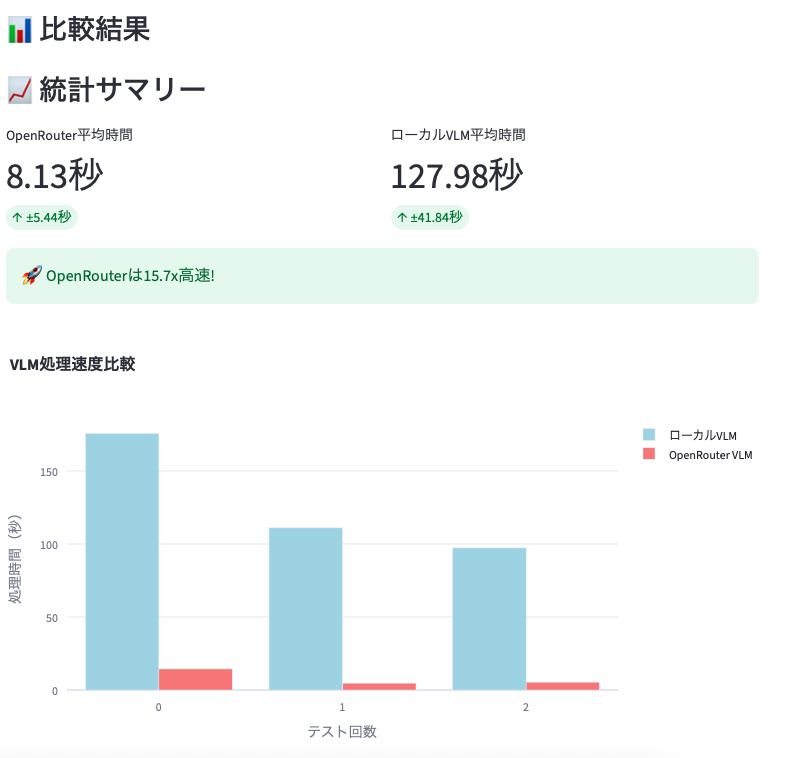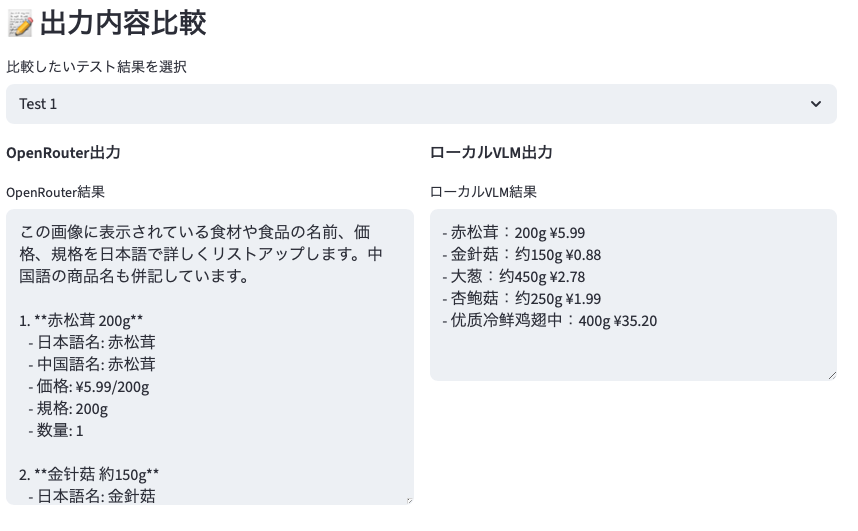はじめに
最近調べ物をしている中で、OpenRouterという個人開発勢&高級なスペックのマシンを持っていない勢にはありがたいサービスを見つけ、主にVLMのモデルを触ってみたので紹介です。
ついでに、VLMモデルのローカル環境での実行と**OpenRouter API経由での実行、での精度比較もしてみました。
検証概要
対象モデル
そもそも2Bと7Bを比べるなんて、、というところもありますが、、、
-
ローカルVLM: Qwen2-VL-2B(ローカル実行)
- ローカルマシンスペック:Apple M4(メモリ16GB)
- OpenRouter API: qwen/qwen-2.5-vl-7b-instruct(クラウド実行)
検証内容
- 食材画像(ショッピングアプリのスクリーンショット等)から商品名・価格・数量を抽出
- 同じプロンプトで複数回実行して処理時間を計測 ※今回は3回
食材画像
Screenshot_20250818_121730_Meituan.jpg
プロンプト
この画像に表示されている食材や食品の名前、価格、規格を日本語で詳しくリストアップしてください。中国語の商品名も併記してください。
実装のポイント
ローカルVLM実装
huggingface-hub cliを用いてローカルにモデルをダウンロードして、
それをLoadする仕組みにしています。
class LocalVLM:
def __init__(self, model_path="./models/qwen2-vl-2b"):
self.model_path = model_path
self.model = None
self.processor = None
def load_model(self):
# transformersを使用してローカルモデルを読み込み
self.model = Qwen2VLForConditionalGeneration.from_pretrained(
self.model_path,
torch_dtype=torch.float32,
device_map=None,
trust_remote_code=True
)
self.processor = AutoProcessor.from_pretrained(
self.model_path,
trust_remote_code=True
)
def extract_food_info(self, image: Image.Image):
# 画像解析の実行
start_time = time.time()
messages = [{
"role": "user",
"content": [
{"type": "image", "image": image},
{"type": "text", "text": "食材情報を抽出してください"}
],
}]
# モデル推論処理...
processing_time = time.time() - start_time
return output_text, processing_time
OpenRouter API実装
class OpenRouterVLM:
def __init__(self, api_key: str):
self.api_key = api_key
self.base_url = "https://openrouter.ai/api/v1/chat/completions"
self.model = "qwen/qwen-2.5-vl-7b-instruct"
def extract_food_info(self, image: Image.Image):
start_time = time.time()
# 画像をBase64エンコード
base64_image = self.image_to_base64(image)
# API呼び出し
response = requests.post(
url=self.base_url,
headers={"Authorization": f"Bearer {self.api_key}"},
json={
"model": self.model,
"messages": [{
"role": "user",
"content": [
{"type": "text", "text": "食材情報を抽出してください"},
{"type": "image_url", "image_url": {
"url": f"data:image/png;base64,{base64_image}"
}}
]
}]
}
)
processing_time = time.time() - start_time
return response.json()['choices'][0]['message']['content'], processing_time
検証結果
処理速度比較
以下の通りClaudeに比較用のStreamlitアプリを作成してもらい3施行実施した結果を分析しています。
言わずもがなって感じですが、OpenRouterの方が圧倒的に応答速度が速いです。用途によるとは思いますが、日常利用で問題ないスピードだと思います。


出力結果についても見てみましたが、どちらもプロンプトの指示通りの結果を出力していますね。
まとめ
今回は、ローカルでパラメータサイズ2Bのモデル、OpenRouterは7Bのモデルを比較したので、シンプルな比較検証にはなりませんでしたが、
セキュアな点を特に気にしなくても良いのであれば、OpenRouterを使った方が楽だし早いしで良さそうですね。
個人開発勢にはとってもありがたい環境です。
ソースコード
自分のために食費管理簿アプリを作成中で、完全なソースコードはGitHubで公開するかもしれません: [リンクは後で追加]

